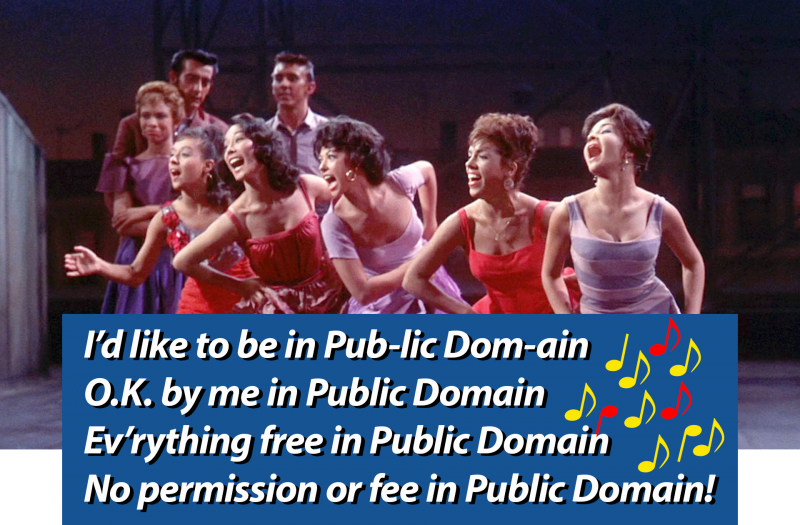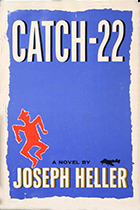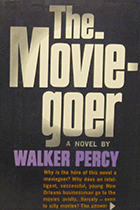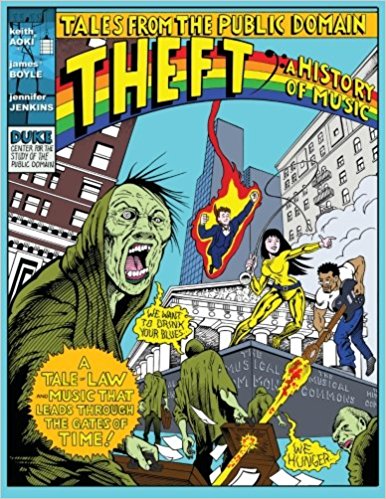
Public Domain Day 2018 Pre-1976
What Could Have Entered the Public Domain on January 1, 2018?
Under the law that existed until 1978 . . . Works from 1961 Tweet

The books Catch-22, Stranger in a Strange Land, and The Phantom Tollbooth, the films Breakfast at Tiffany’s and West Side Story, and more. . .
Current US law extends copyright for 70 years after the date of the author's death, and corporate “works-for-hire” are copyrighted for 95 years after publication. But prior to the 1976 Copyright Act (which became effective in 1978), the maximum copyright term was 56 years—an initial term of 28 years, renewable for another 28 years. Under those laws, works published in 1961 would enter the public domain on January 1, 2018, where they would be “free as the air to common use.” Under current copyright law, we’ll have to wait until 2057.1 And no published works will enter our public domain until 2019. The laws in other countries are different—thousands of works are entering the public domain in Canada and the EU on January 1.
Catch-2057
What books would be entering the public domain if we had the pre-1978 copyright laws? You might recognize some of the titles below.
- Joseph Heller, Catch-22
- Walker Percy, The Moviegoer
- J.D. Salinger, Franny and Zooey
- John Howard Griffin, Black Like Me
- Irving Stone, The Agony and the Ecstasy
- Muriel Spark, The Prime of Miss Jean Brodie
- Robert A. Heinlein, Stranger in a Strange Land
- William S. Burroughs, The Soft Machine
- Norton Juster, The Phantom Tollbooth
- Roald Dahl, James and the Giant Peach

Taking remix to another level, Burroughs wrote The Soft Machine using the "cut-up technique," where existing text is cut up and rearranged to create a new work. (Image from BOO-HOORAY's exhibit Cut-Ups: William S. Burroughs 1914–2014.)
What a trove of books! They are but a fraction of what would be entering the public domain on January 1. Imagine them being freely available to students and educators around the world—many of the themes in these books certainly resonate today.
You would be free to use these books for theater, or make them into a film. You could translate them into other languages, or create accessible Braille or audio versions.2 You could read them online or buy cheaper print editions, because others were free to republish them. Empirical studies have shown that public domain books are less expensive, available in more editions and formats, and more likely to be in print—see here, here, and here. Imagine a digital Library of Alexandria containing all of the world’s books from 1961 and earlier, where, thanks to technology, you can search, link, annotate, copy and paste. (Google Books has brought us closer to this reality, but for copyrighted books where there is no separate agreement with the copyright holder, it only shows three short snippets, not the whole book.) Instead of seeing these literary works enter the public domain in 2018, we will have to wait until 2057.
The Copyright Trap
Consider the films from 1961 that would have become available this year. You could share clips with friends or incorporate them into fan fiction. Community theaters could show the full features. Libraries and archivists would be free to digitize and preserve them. Here are a few of the movies that we won’t see in the public domain for another 39 years.
- Breakfast at Tiffany’s
- West Side Story
- The Guns of Navarone
- A Raisin in the Sun
- The Parent Trap
- Splendor in the Grass
- Judgment at Nuremberg
- The Misfits
- The Hustler
 If these films were in the public domain, you could use them in your own works, just as they used earlier works in theirs. West Side Story (music by Leonard Bernstein, lyrics by Stephen Sondheim, book by Arthur Laurents) was free to draw upon Romeo and Juliet because Shakespeare’s work was in the public domain. And as Judge Richard Posner observed, if the underlying works were copyrighted, “Romeo and Juliet itself would have infringed Arthur Brooke’s The Tragicall Historye of Romeo and Juliet . . . which in turn would have infringed several earlier Romeo and Juliets, all of which probably would have infringed Ovid’s story of Pyramus and Thisbe.” One work inspires another. That is how the public domain feeds creativity.
If these films were in the public domain, you could use them in your own works, just as they used earlier works in theirs. West Side Story (music by Leonard Bernstein, lyrics by Stephen Sondheim, book by Arthur Laurents) was free to draw upon Romeo and Juliet because Shakespeare’s work was in the public domain. And as Judge Richard Posner observed, if the underlying works were copyrighted, “Romeo and Juliet itself would have infringed Arthur Brooke’s The Tragicall Historye of Romeo and Juliet . . . which in turn would have infringed several earlier Romeo and Juliets, all of which probably would have infringed Ovid’s story of Pyramus and Thisbe.” One work inspires another. That is how the public domain feeds creativity.
The films above are famous, so thanks to projects like the National Film Registry, we’re not likely to lose them entirely. The true tragedy is that of forgotten films that are literally disintegrating while preservationists wait for their copyright terms to expire.3
Let’s Twist Again . . . Like We Did 56 Years Ago
 What 1961 music could you have used without fear of a lawsuit? If you wanted to find guitar tabs or sheet music and freely use some of the influential music from 1961, January 1 2018 would have been a rocking day for you under earlier copyright laws. Patsy Cline’s classic Crazy (Willie Nelson) would be available. So would Stand By Me (Ben E. King, Jerry Leiber, Mike Stoller), Runaway (Del Shannon, Max Crook), and Let’s Twist Again (Kal Mann, Dave Appell). You could publicly perform or set short films to Surfin' (Brian Wilson, Mike Love) or Crying (Roy Orbison, Joe Melson), all without permission or fee. Today these musical works remain copyrighted until 2057.4
What 1961 music could you have used without fear of a lawsuit? If you wanted to find guitar tabs or sheet music and freely use some of the influential music from 1961, January 1 2018 would have been a rocking day for you under earlier copyright laws. Patsy Cline’s classic Crazy (Willie Nelson) would be available. So would Stand By Me (Ben E. King, Jerry Leiber, Mike Stoller), Runaway (Del Shannon, Max Crook), and Let’s Twist Again (Kal Mann, Dave Appell). You could publicly perform or set short films to Surfin' (Brian Wilson, Mike Love) or Crying (Roy Orbison, Joe Melson), all without permission or fee. Today these musical works remain copyrighted until 2057.4
 Like West Side Story, some of the hit songs from 1961 borrowed from earlier works. Elvis Presley’s Surrender (Doc Pomus, Mort Shuman) was adapted from the 1902 Neapolitan ballad "Torna a Surriento" (Ernesto and Giambattista de Curtis), and his Can’t Help Falling in Love (Hugo Peretti, Luigi Creatore, George David Weiss) is derived from the 1784 French song "Plaisir d’amour" (Jean-Paul-Égide Martini). (To read more about the rich history of borrowing in music, see our free comic book!)
Like West Side Story, some of the hit songs from 1961 borrowed from earlier works. Elvis Presley’s Surrender (Doc Pomus, Mort Shuman) was adapted from the 1902 Neapolitan ballad "Torna a Surriento" (Ernesto and Giambattista de Curtis), and his Can’t Help Falling in Love (Hugo Peretti, Luigi Creatore, George David Weiss) is derived from the 1784 French song "Plaisir d’amour" (Jean-Paul-Égide Martini). (To read more about the rich history of borrowing in music, see our free comic book!)
For art lovers, 1961 also featured works such as Roy Lichtenstein’s Look Mickey!,5 a pop culture commentary based on an image from Disney’s Donald Duck: Lost and Found. Lichtenstein was not sued for copyright infringement, but today’s Lichtenstein might very well face a lawsuit. Until works enter the public domain, an artist wanting to legally reuse them as Lichtenstein did would have to rely on “fair use,” a doctrine that allows uses of copyrighted expression for purposes including commentary and criticism. Fair use is a valuable exception, but its application can be complex and unpredictable in practice. It’s unclear whether Look Mickey! would be protected by fair use. (To learn more about fair use, you can read our comic book on the subject, Bound By Law, here.)
Science from 1961—copyrighted research, still behind paywalls
 1961 was another noteworthy year for science, including foundational developments in the search for extraterrestrial intelligence (SETI). Frank Drake developed the Drake equation for estimating the likelihood of finding extraterrestrial civilizations in the Milky Way. And while other researchers were focused on detecting alien communication via radio signals, Charles H. Townes and R.N. Schwartz suggested that aliens might also communicate using optical masers in their article “Interstellar and Interplanetary Communication by Optical Masers,” published in the journal Nature. But if you want to read that article, and you do not have a subscription or institutional access, you will encounter a paywall. The same is true for other articles from the same issue of Nature such as “Dynamics and Energetics of Swimming in Water-Beetles” or “Cosmic Ray Ages of the Treysa and Sikhote–Alin Meteorites.”
1961 was another noteworthy year for science, including foundational developments in the search for extraterrestrial intelligence (SETI). Frank Drake developed the Drake equation for estimating the likelihood of finding extraterrestrial civilizations in the Milky Way. And while other researchers were focused on detecting alien communication via radio signals, Charles H. Townes and R.N. Schwartz suggested that aliens might also communicate using optical masers in their article “Interstellar and Interplanetary Communication by Optical Masers,” published in the journal Nature. But if you want to read that article, and you do not have a subscription or institutional access, you will encounter a paywall. The same is true for other articles from the same issue of Nature such as “Dynamics and Energetics of Swimming in Water-Beetles” or “Cosmic Ray Ages of the Treysa and Sikhote–Alin Meteorites.”
A distressing number of scientific articles from 1961 require payment or a subscription or account, including those in major journals such as Science and JAMA,6 both of which charge $30 to view a single article from 1961 for 24 hours. Want to read a 1961 article about graduate medical education? Here's the payment page. Want to read “An Experiment in the History of Science: With a simple but ingenious device Galileo could obtain relatively precise time measurements”? If you go to Science’s page to purchase digital access, you will see that you can purchase access for 1 day for $30 US—but that’s not all. You also have to agree to the following restrictions and conditions: “You may view, download, and/or print the article for your personal scholarly, research, and educational use” but may not distribute or post it, and you must agree both to accept cookies and be contacted from time to time about the publisher’s products. Of course, many scientists will have institutional access to these journals, but this access is not guaranteed—even institutions such as Harvard have considered canceling their subscriptions because they could no longer afford the escalating prices of major journal subscriptions.
It’s remarkable to find scientific research from 1961 hidden behind publisher paywalls. Thankfully, some publishers have made older articles available in full online, so that you can read them, even though it may still be illegal to copy and distribute them. In addition, some older articles have been made available on third party websites, but this is not a stable solution for providing reliable access to science. Third party postings can be difficult to find or taken down, links can get broken, and would-be posters may be deterred by the risk of a lawsuit. Under the pre-1978 copyright term, all of this history would be free to scholars, students, and enthusiasts.
Not all scientific publishers work under this kind of copyright scheme. “Open Access” scientific publications, like those of the Public Library of Science, are under Creative Commons licenses, meaning that they can be copied freely from the day they are published.
Works from 1989!
Most of the works highlighted here are famous—that is why we included them. And if that fame meant that the work was still being exploited commercially 28 years after its publication, the rights holders would probably renew the copyright. But we know from empirical studies that 85% of authors did not renew their copyrights (for books, the number is even higher—93% did not renew), since most works exhaust their commercial value very quickly.
Under the law that existed until 1978 . . . Up to 85% of all copyrighted works from 1989 might have been entering the public domain on January 1, 2018.
That means that all of these examples from 1961 are only the tip of the iceberg. If the pre-1978 laws were still in effect, we could have seen 85% of the works published in 1989 enter the public domain on January 1, 2018. Imagine what that would mean to our archives, our libraries, our schools and our culture. Such works could be digitized, preserved, and made available for education, for research, for future creators. Instead, they will remain under copyright for decades to come, perhaps even into the next century.
Perhaps the most troubling aspect of the current copyright term is that in most cases, the cultural harm is not offset by any benefit to an author or rights holder. Unlike the famous works highlighted here, the vast majority of works from 1961 do not retain commercial value,7 but they are off limits to users who do not want to risk a copyright lawsuit. This means that no one is benefiting from continued copyright, while the works remain both commercially unavailable and culturally off limits. The public loses the possibility of meaningful access for no good reason. You can read more about the current costs associated with orphan works—works that are still presumably under copyright, but with no identifiable or locatable copyright holder—here and here. Importantly, the US Copyright Office has been engaged in efforts to find solutions to the orphan works problem. However, unlike other countries, the US has not enacted any such solutions.
1 The copyright term for works published between 1950 and 1963 was extended to 95 years from the date of publication, so long as the works were published with a copyright notice and the term renewed (which is generally the case with famous works such as those we are highlighting).
Many works published in 1961 are already in the public domain because the copyright holder did not comply with notice, renewal, or other copyright formalities. However, tracking down this information can be difficult (you can read just one of many illustrative examples collected by the Copyright Office here). Therefore, users often have to presume these works are copyrighted or risk a lawsuit (only works published before 1923 are conclusively in the public domain). You can read more about copyright terms from this excellent chart and from the US Copyright Office’s guide.
It is also difficult to determine whether foreign works are in the public domain in the U.S. Generally speaking, as a result of international agreements, foreign works published after 1923 are still under copyright in the US as long as one of the following is true: they were published in compliance with US formalities, they were still copyrighted in their home countries as of 1996, or they were then published in the US within 30 days of publication abroad. You can learn more about copyright terms for foreign works from the Copyright Office guide here.
2 If you think publishers have not objected to this, you would be wrong. US copyright law has an exception that allows books to be reproduced in accessible formats, but this exception only applies to “authorized entities”—nonprofits or governmental agencies with a primary mission related to providing such services.
3 The law allows libraries and archives (not preservationists generally) to digitize works during the last 20 years of their copyright term, but only in limited circumstances: the library or archive first has to determine through a “reasonable investigation” that the work is not being commercially exploited and that they cannot obtain another copy of it at a reasonable price.
4 Under federal law at the time, these “musical compositions”—the music and lyrics—were subject to copyright, but the particular “sound recordings” embodying the musical compositions were not; federal copyright did not cover sound recordings until 1972. (Pre-1972 sound recordings are protected under some states' laws.) So, for example, the musical composition “It's Now or Never” written by Wally Gold and Aaron Schroeder would be federally copyrighted, but not Elvis Presley's particular sound recording of that composition.
5 While we were able to find copyright renewals for all of the books, movies, and songs mentioned on this page (meaning that they are in fact copyrighted through 2057), we weren’t able to track down a renewal for “Look Mickey!” This doesn’t mean it’s not copyrighted — Lichtenstein’s estate has made copyright claims over other works in the past — just that we couldn’t locate the renewal in the Copyright Office database (as explained above, this can sometimes be difficult).
6 Sometimes you can see the first archived journal article you choose, but the remaining articles are behind a paywall. And even when 1961 articles are readable, they’re still copyrighted—these publishers won’t allow you to reproduce or distribute them without permission.
7 A Congressional Research Service study indicated that only 2% of works between 55 and 75 years old continue to retain commercial value. As explained above, many works from 1961 are technically in the public domain, but it is often difficult to conclusively determine public domain status, so users have to presume that they’re still under copyright.
![]() The Public Domain Day 2018 web pages by Duke University's Center for the Study of the Public Domain are licensed under a Creative Commons Attribution-ShareAlike 4.0 International License.
The Public Domain Day 2018 web pages by Duke University's Center for the Study of the Public Domain are licensed under a Creative Commons Attribution-ShareAlike 4.0 International License.























